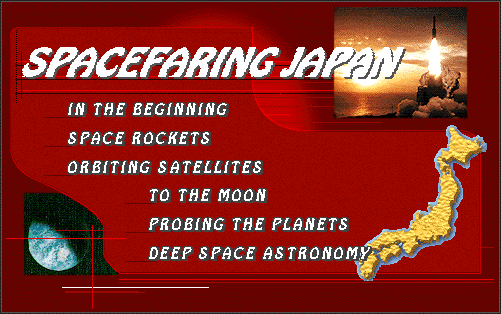

Japan Exploring Our Solar System . . .
Solar-B Watching Eruptions on the Sun
Satellites Rockets Surveying the Moon Exploring Planets
Solar-B is investigating those magnificent, large explosions in the Sun's atmosphere known as solar flares.
JAXA artist cocnept of Solar-B Hinode studying the Sun from orbit above Earth.
Japan launched the observation satellite on September 22, 2006, on a joint mission with the United States and Britain. JAXA is Japan's space agency.
The 1,984-lb. satellite was sent aloft from the Uchinoura Space Center on Kagoshima Island at the southern end of Japan to a north-south, Sun-synchronous, polar orbit around Earth from where it looks continuously at the Sun.
In orbit, Solar-B was renamed Hinode.
Solar-B was Japan's third solar observation satellite following launches in 1981 and 1991. Astro-A, also known as Hinotori , worked in orbit from 1981-1991. Solar-A, or Yohkoh, was a successful Japanese, American, British satellite in space between 1991 and 2001.
Hinotori is Japanese for firebird. Yohkoh is sunbeam. Hinode is sunrise.
Eruption observer. Solar flares are very dramatic events in which energy equal to tens of millions of hydrogen bombs is released by the Sun in just moments.
Flares fire bursts of radiation and super-fast particles in the direction of Earth. When they get here, they burn the electronic components of some satellites in orbit and disrupt radio signals and power transmissions down on the surface of our planet. They also pose a health threat to astronauts in space.
Sometimes the particles fly so fast they can cover the 149 million km to Earth in just tens of minutes.
JAXA photo of Solar-B launching on a Japanese M-V-7 rocket on September 22, 2006. The satellite was renamed Hinode when it arrived in orbit above Earth.
Solar-B will help scientists on Earth learn more about magnetic fields, which they think are the power behind solar flares. Scientists want to know how the Suns magnetic fields trigger the solar flares.
Researchers want to know why the outer atmosphere of the Sun, with temperatures of two to three million degrees Celsius, are far hotter than the Sun's surface temperature of 6,000 degrees Celsius.
The astronomy gear. Solar-B has three instruments – a Solar Optical Telescope (SOT), an X-ray Telescope and an Extreme Ultraviolet Imaging Spectrometer.
Solar-B will observe our star for 12 months of the year. It will not pass through the blackness of nighttime for eight months a year. Engineers
Ironically, the satellite is powered by energy it receives from the Sun. It may work in space for as long as 10 years, which is almost an entire 11-year solar activity period known as the sunspot cycle..
Solar-B was built for JAXA by the Mitsubishi Electric Corporation. It carries scientific and engineering equipment from the United States and the United Kingdon.
Solar-B is but one of a fleet of spacecraft from Earth dedicated to understanding the relationship between the Sun and Earth. For instance, NASA's Stereo mission is composed of twin spacecraft that will snap 3D images of the Sun.
The launch site. ISAS is the acronym for Institute of Space and Astronautical Science. Within JAXA, the institute is dedicated to space and astronautical science research for Japan.
ISAS launches its rockets from Kagoshima Space Center (KSC), which is at Uchinoura on the east of the Ohsumi Peninsula in Kagoshima Prefecture.
KSC was founded in 1962. It's mostly hilly terrain has facilities for launching rockets, receiving telemetry, and tracking and observing flights. More than 300 rockets have been launched from there since 1962.
ISAS also has facilities for static firing tests, rocket, satellite and balloon launches, and deep space tracking scattered across Japan.
Asian space race. JAXA launched two observation satellites on two large H-2A rockets from the southern island of Tanegashima in January and February 2006.
In September 2006, the Japanese space agency launched the nation's third intelligence-gathering spysat. Japan and its neighbors in the region are concerned about North Korea's missiles and nuclear weapons.
Japan has said it is reconsidering its current focus on unmanned missions and now intends to send an astronaut into space and set up a base on the moon by 2025. China sent astronauts into space in 2003 and 2005.
Learn more... Solar-B Hinode JAXA Solar-B NAOJ Solar-B UK Solar-B NASA
Yohkoh Public Outreach Project The Yohkoh Satellite - NASA Solar Astronomy Web Index ISAS Launch History
JAXA ISAS NASDASPACEFARING JAPAN: HISTORY ROCKETS SATELLITES MOONS PLANETS ASTRONOMY JAPAN
CHINA INDIA EUROPE SEARCH STO STO COVER QUESTIONS SUGGESTIONS E-MAIL
© 2006 SPACE TODAY ONLINE